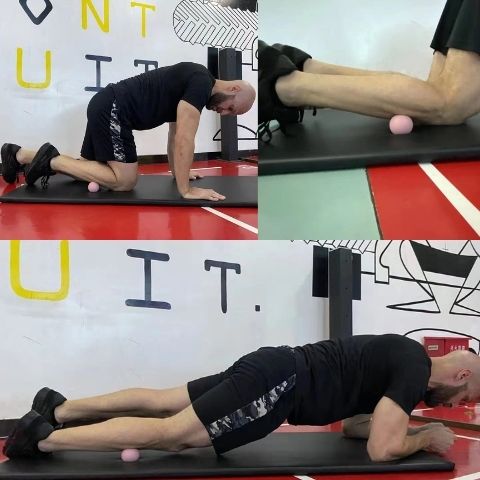Want your perfect workout program?
Take Quiz9 Best Tibialis Anterior Stretches & Exercises (Plus Myofascial Release)

Written by Kiel DiGiovanni | Co-founder
Fact checked by Kirsten Yovino, CPT Brookbush Institute
 FACT CHECKED
FACT CHECKED
The tibialis anterior is a highly used muscle that rarely gets enough love. And while you may not be familiar with this lower leg muscle, it’s crucial to stretch and exercise it to avoid potential pain, like shin splints, in the future.
Anytime you walk, run or jump your tibialis anterior muscle is working to move you forward by flexing your ankles. This article will go over the 9 best tibialis anterior stretches and strengthening exercises, so you can continue moving, walking, running, and jumping pain free.
We'll then give you a few massage techniques to help to relax the tibialis anterior muscle to reduce pain and answer any questions you may have regarding shin splints or tibialis anterior pain.
Table of Contents:
- What Is The Tibialis Anterior?
- 9 Best Tibialis Anterior Stretches & Exercises
- Tibialis Anterior Massage Self Treatment
- Causes of Tight Tibialis Anterior Muscles
- Who Should Stretch And Exercise The Tibialis Anterior?
- Benefits of Strengthening & Stretching The Tibialis Anterior
- FAQs

What is the tibialis anterior & what does it do?
The tibialis anterior name is derived from the Latin words tibia meaning shinbone and anterior from the word ante meaning before. The anterior tibialis is found on the anterior (front) of the lower leg.
Tibialis Anterior Functions:
- Largest of the dorsiflexor muscles and responsible for ankle dorsiflexion and inversion of the foot.
- Supports the ankle in horizontal movement as it inverts the ankle helping to reduce damage if the ankle is rolled.
- Walking, running and any other movement that requires the leg to move is supported by the tibialis anterior.
- The tibialis anterior muscle stabilizes the ankle when the foot comes into contact with the ground while walking it then helps to lift the foot off the ground.
- Holds the ankle in place during isometric contraction (think of when your ankle is flexed and your toes are pointing upwards).

9 Best Tibialis Anterior Stretches and Exercises
Stretching and strengthening the often overlooked tibialis anterior muscle can lessen your chances of experiencing anterior tibialis pain or shin splints.
The 9 best tibialis anterior stretches and exercises are:
- Kneeling Tibialis Anterior Stretch
- Seated Tibialis Anterior Stretch
- Lying Tibialis Anterior Stretch
- Standing Tibialis Anterior Stretch
- Band Calf Stretch
- Band Foot Drop
- Seated Toe Raises
- Wall Toe Raises
- Heel Walk
When stretching or exercising the lower legs many people focus their efforts on the calves. It's important to include the tibialis anterior muscle stretching and exercising into your routine to avoid disparity between the front and back of your lower legs.
Note: Exercises 1-6 are stretches, while exercises 7-9 are for strengthening.
1. Kneeling Tibialis Anterior Stretch

- Get on the floor on your hands and knees
- Turn your toes inwards then sit back on your calves
- Hold for up to 20 seconds then return to starting position
- Repeat for desired reps
Note: Get a deeper stretch by lifting your knees off the floor, pressing your upper feet into the ground with your hands on the floor front of you for support.
2. Seated Tibialis Anterior Stretch

- Sit on a chair or bench to perform this seated shin stretch
- Lower your knee then place the top of your foot on the ground behind you
- Lean forward slightly, pressing into the ground with the top of your foot
- Hold for up to 20 seconds
- Repeat with the other leg
3. Lying Tibialis Anterior Stretch

- Lie down on your side then bend your lower leg’s knee back behind you like you’re going to do a quad stretch
- Reach behind and grab your foot pulling it gently towards your back
- Hold for 10-20 seconds
- Repeat with the other leg
4. Standing Tibialis Anterior Stretch

- Stand with feet hip width apart with your knees slightly bent
- Place one foot behind you with the top of your foot pressing into the ground
- Keeping the top of your foot on the floor, lean forward pushing through the top of your foot
- Hold for 10-20 seconds
- Repeat with the other leg
5. Band Calf Stretch

- Sit down on the floor then grab a band or towel and wrap around your foot near the toes
- Extend your leg out in front of you
- Pull towards you so that your ankle is flexed up
- Hold for 15-30 seconds
- Repeat with the other leg
6. Band Foot Drop

- Loop a resistance band around an anchor close to the floor
- Sit down then loop the band over your foot
- Flex your ankle up towards you, briefly hold at the top
- Slowly return to starting position
- Repeat for 10-15 repetitions
- Switch sides
For more great leg stretches that utilize a band, check out our article: 7 Best Stretches for Tight Legs Using Resistance Bands.
7. Seated Toe Raises

This exercise kick-starts our strengthening exercises list.
Note: You can also add in some isometric tibialis anterior exercises into the mix if recovering from injury. To do these you'll flex your ankle up to press against an object without moving it to create steady contraction.
- Sit on a chair with your feet in front of you
- Slowly raise your toes off of the floor
- Hold for 1-2 seconds at the top
- Repeat for 3 sets of 10-15 reps
8. Wall Toe Raises

- Stand 12 inches away with your back towards the wall with feet hip width apart
- Keep your knees slightly bent then lean back into the wall
- Raise your toes off the ground and hold at the top for 1-2 seconds then lower toes back to the ground
- Repeat for 3 sets of 10-20 reps
9. Heel Walk

- Stand on both feet hip width apart with no shoes on, beginning with feet flat on the floor
- Raise your toes off the ground so that your heels are in contact with the ground
- Walk forward while leaning back placing your weight on your heels
- Do this for 30-45 seconds
- Repeat 3 times
Note: Repeat this exercise but walk only on the balls of your feet to stretch and strengthen your calves and tibialis anterior.
For more lower leg strengthening moves, head to our article on the 28 Greatest Gastrocnemius Exercises.
Tibialis Anterior Massage Self Treatment
Self-massage or trigger point therapy on the tibialis anterior can help to ease the tightness and pain in the muscle. If you were wondering how you can massage the tibialis anterior, we have you covered with these few easy techniques to relax the tibialis anterior. These massages can be done at home with as little as a massage ball or even a tennis ball.
Tibialis Anterior Vertical or Lateral Massage

- Put massage ball, tennis ball or foam roller on the ground
- Place tibialis anterior muscle on the ball by rotating your leg internally
- Roll up and down lengthwise on the muscle
- Do this for 30-60 seconds
- Repeat with the other leg
Note: This can also be done by moving laterally across the muscle rather than vertically.
Tibialis Anterior Press and Flex

- Sit on the floor with your leg extended out in front of you
- Apply pressure to the trigger points on your muscle using a roller stick or massage ball
- While applying pressure flex your ankles up and down
- Do this for 30-60 seconds
- Repeat with the other leg
Note: You can also do this with just your fingers by pressing into the trigger points.
For more information on trigger point therapy, check out the 12 Best Massage Ball Movements for Full Body Massage.
What causes tight tibialis anterior muscles?
Tight anterior tibialis muscles can be rather annoying as it makes the simple task of walking unpleasant. The causes of tight tibialis anterior can lead to shin splints and can be a result of any of the following:
- Direct trauma to the muscle area
- Intense workouts or prolonged workouts where your ankle is constantly flexed upwards
- Running, jumping or other high impact activities on hard surfaces
- Imbalance gait while walking or running
- Sudden change in exercise routine
Who should stretch and exercise the tibialis anterior?
Everyone should stretch and strengthen the tibialis anterior muscle. This relatively small muscle is vital to our movement so if you walk then you should be doing tibialis anterior stretches and exercises. This is especially true for anyone who partakes in running or jumping activities. A strong and relaxed tibialis anterior muscle can help counteract the negative side effects of the high impact of your feet hitting the ground constantly.
Benefits of Stretching and Exercising the Tibialis Anterior Muscle
Just like any other muscle, it's beneficial to stretch and strengthen the tibialis anterior muscle. By keeping this lower leg muscle supple and sturdy you'll be able to move freely without pain for longer periods of time plus your legs will look great from the front!
If you add anterior tibialis muscle stretches and exercises into your training program, you'll reap the following benefits:
- Reduced risk of injury to calves, ankles and feet
- Decreased chance of getting tibialis anterior tendonitis
- Imrpoved ground clearance when walking to avoid tripping
- Lower risk of developing shin splints and stress fractures
- Speed up recovery of pain in the shin muscles and shin splints.
- Improved athletic performance in sports where the ankle is "locked" like in soccer to kick a ball
SHIN SPLINTS FAQs
Let's answer some questions related to shin splints and your tibialis anterior.
What causes pain in the tibialis anterior?
The most common cause of pain in the tibialis anterior is overuse. Runners commonly suffer from this pain often called shin splints. Journal of Orthopedic & Sports Physical Therapy reported that shin splints accounted for 10.7 percent of injuries to male runners while they accounted for 16.8 percent of injuries for female runners1. The high impact toll that running takes on the body means that tibialis anterior stretching should be a consistent part of any runner's training program.
How to tell if you have shin splints or stress fractures?
Shin splint pain will generally dissipate a little after you’ve warmed up but stress fractures will continue to get worse if you don’t stop physical activity. A doctor will diagnose stress fractures via physical examination, X-ray, MRI or bone scan. Stress fractures require immediately stopping any physical exercise that might have caused it. Stress fractures can take anywhere from two to eight weeks to heal. Low impact exercises such as swimming or biking can be done to help the recovery process. In the worst cases a crutch or even a cast may be needed.
How long does it take shin splints to heal?
Most of the time pain from shin splints will go away in two to four weeks after the legs have had time to heal. Once healed people can resume their training but it is important to include tibialis anterior stretches as a regular part of your regimen.
Keep in mind that shin splints should be taken seriously and treated as such so they don’t lead to stress fractures which will have you out of action for up to a few months. As soon as you start to feel any pain from shin splints then you should begin to do shin splint stretches.
Should you massage shin splints?
Yes! Myofascial release, trigger point therapy or deep tissue massage will help to ease shin splint pain. The combination of massage, stretching and strengthening will help speed up the recovery time from shin splints.
How to prevent shin splints?
Medial tibial stress syndrome (MTSS) A.K.A shin splints happen when too much stress is put on the tibia or the when the tibialis anterior muscle is overworked. To prevent shin splits from happening in the first place you can take the following precautions.
- Try to stay away from high impact exercises on hard surfaces
- Stretch hamstrings and calves frequently
- Make sure that your footwear is sized properly
- Stay at a healthy body weight to reduce stress on lower legs
- Have a professional analyze your gait, running and jumping form
- Strengthen your hip and feet muscles
- Avoid drastic changes to exercise regimen, ease into it
Tibialis Anterior PAIN FAQs
Additional questions regarding tibialis anterior pain? Let's answer them here.
What are Symptoms of Tibialis Anterior Muscle Strain?
It’s important to pinpoint the exact issue causing you pain in the tibialis anterior region. You could be experiencing pain from your knee down to your big toe. These symptoms are often experienced when the foot is flexed upward during daily activities such as walking, running, climbing stairs or even seemingly easy movements like lifting your foot off the gas/brake pedals while driving.
These symptoms may come and go throughout the day be on going depending on the severity of the strain or the stress the muscles have gone through.
The common symptoms of tibialis anterior strain are felt in the lower front leg, ankle and/or foot.
- Weakness when flexing your ankle upwards
- Swelling
- Aching, Sharp Burning or Cramping Pain
- Increased tension and/or pressure
What is tibialis anterior tendonitis?
Anterior tibialis tendonitis is the inflammation of the tibialis anterior tendon or the degradation of the tendon sheath (a thin layer of tissue that helps protect tendons from damage during movement). One thing you can do to reduce your chances of getting anterior tibialis tendonitis is to wear the proper size shoes.
What are Symptoms of tibialis anterior tendonitis?
Symptoms of tibialis anterior tendonitis can feel similar to tibialis anterior muscle strain. People will often fell stiffness or pain on the front of the ankle. Overuse, especially high impact activities on hard surfaces is the most common cause of this problem that will have you experiencing pain when lifting the toes or foot. Other factors that can lead to tibialis anterior tendonitis are bad foot biomechanics, wearing the wrong shoes, or tight lower leg muscles.
How long does tibialis anterior tendonitis take to heal?
Treatments of tibialis anterior tendonitis are similar to treating tibialis anterior muscle strain of RICE (Rest Ice Compression Elevation), stretching, exercises to strengthen, balance training and even orthotics. Recovery can take a few weeks up to a few months depending on the severity of the inflammation. Catching this early on before it becomes a big problem will shorten the recovery period.
How do you fix pain in the tibialis anterior?
You should figure the original cause of the tibialis anterior pain if you want to properly treat it. Next, consult with a doctor who can diagnose then medically treat the pain. A normal protocol to follow until you can visit a medical professional is the RICE method.
- Stretching
- Strengthening exercises
- Hot and cold therapy
- Joint mobilization
- Adjustments to exercise regimen
Tibialis Anterior Stretches & Exercises: Final Takeaways
A strong and healthy tibialis anterior muscle is necessary if you want to continue your normal exercise routine without being sidelined due to unneccessary pain. Add a few anterior tibialis stretches and exercises into your training program to keep your lower legs pain free.
While stretching your tibialis anterior, take a few moments to also include some Glute Stretches and Quad Stretches in your lower body routine.
References:
- Plisky MS, Rauh MJ, Heiderscheit B, Underwood FB, Tank RT. Medial Tibial Stress Syndrome in High School Cross-Country Runners: Incidence and Risk Factors. Journal of Orthopaedic & Sports Physical Therapy. 2007;37(2):40-47. doi:https://doi.org/10.2519/jospt.2007.2343

Also in Blog
Recent Articles
-
Calories In, Calories Out Myth: Fact or Fiction?April 08, 2025
-
Cardio Or Strength Training: What's Better For Weight Loss?April 03, 2025
Must Reads
-
Mr Olympia 2024: What to Expect This Year (Oct. 10-13, 2024)September 11, 2024
-
What Can Walking For 1 Hour Everyday Do For You? My ExperienceFebruary 28, 2024
-
The Ultimate "Bro Split" Workout Plan (Backed By Science)August 05, 2023
- Blog
- Exercises
- Workouts
- Meal Plans
- SFS Programs
- Apparel
- About Us
- FAQ
- Shipping
- Warranty
- Contact Us
- Terms & Conditions
- Privacy Policy
- Affiliates
- SFS UGC Policy
- SFS MBG Policy
- Disclosures
- Legal Disclaimer
Sign up to get the latest on sales, new releases and more…
© 2025
SET FOR SET.
Powered by Shopify
















Kiel DiGiovanni
Author